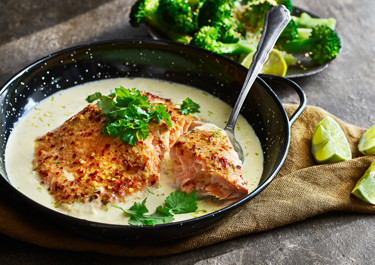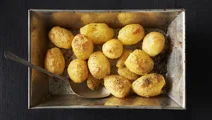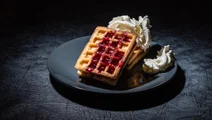Asian salmon
&format=webp)
Baked salmon is always a popular dish, and this recipe is one that takes care of itself in the oven. Seasoned with Asian-inspired flavours of ginger, chilli and lime, topped with freshly chopped coriander, this Asian salmon is the perfect meal for any occasion!
Ingredients
Baked salmon
|
Skinless salmon fillet
|
600 g |
|---|---|
|
Flake salt
|
2 tsp |
|
Brown sugar
|
1 tsp |
|
Ground ginger
|
1 tsp |
|
Chilli flakes
|
1 tsp |
|
Double cream
|
200 ml |
|
Freshly squeezed lime juice and zest
|
1 |
|
Garlic clove
|
1 |
Serve with
|
Jasmine rice
|
4 portions |
|---|---|
|
Broccoli
|
1 |
|
Toasted sesame seeds
|
2 tbsp |
|
Chopped fresh coriander
|
Instructions
Step 1
Step 2
Step 3
Step 4
Step 5
Step 6
Questions about Asian salmon
Read below to find out about the frequently asked questions about Asian salmon.
What flavours work well with salmon?
Can you eat salmon skin?
Can you cook salmon in a wok?
How do you cook the perfect salmon?
Sidekicks for your Asian Salmon
For this recipe, we recommend a steaming bowl of jasmine rice and blanched broccoli with sesame seeds. Adding a touch of coconut to the rice (simply replace 400 ml of water with coconut milk) will not only welcome another Asian flavour to your meal, it also pairs very well with the salmon and sauce. Lemon roasted baby potatoes, sauteed green beans or a crunchy fennel and herb salad are also great pairings for this dinner table.
Vegetarian-friendly swaps for the meat-free crowd
Popular fish substitutes include tempeh, banana blossoms (a purple and fleshy flower that grows under a banana bunch) or jackfruit (a tropical tree fruit that is grown in Asia, Africa, and South America). Each of these options have a neutral flavour and can, to some degree, mimic the firm and fleshy texture of fish.
Store your Asian salmon like this
You can safely store any leftovers for up to two days in an airtight container in the lower part of the refrigerator where it's coldest. If the leftovers have been kept at room temperature for longer than two hours, it's safer to throw the fish out as harmful bacteria could have multiplied beyond a point that is considered safe to eat.






